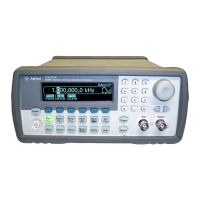279
Chapter 4 Remote Interface Reference
An Introduction to the SCPI Language
4
Querying Parameter Settings
You can query the current value of most parameters by adding a
question mark (“?”) to the command. For example, the following
command sets the output frequency to 5 kHz:
"FREQ 5000"
You can then query the frequency value by executing:
"FREQ?"
You can also query the minimum or maximum frequency allowed with
the present function as follows:
"FREQ? MIN"
"FREQ? MAX"
SCPI Command Terminators
A command string sent to the function generator must terminate with a
<new line> character. The IEEE-488 EOI (End-Or-Identify) message is
interpreted as a <new line> character and can be used to terminate a
command string in place of a <new line> character. A <carriage return>
followed by a <new line> is also accepted. Command string termination
will always reset the current SCPI command path to the root level.
IEEE-488.2 Common Commands
The IEEE-488.2 standard defines a set of common commands that
perform functions such as reset, self-test, and status operations.
Common commands always begin with an asterisk ( ), are three
characters in length, and may include one or more parameters.
The command keyword is separated from the first parameter by a
blank space. Use a semicolon ( ; ) to separate multiple commands as
shown below:
"*RST; *CLS; *ESE 32; *OPC?"
*

